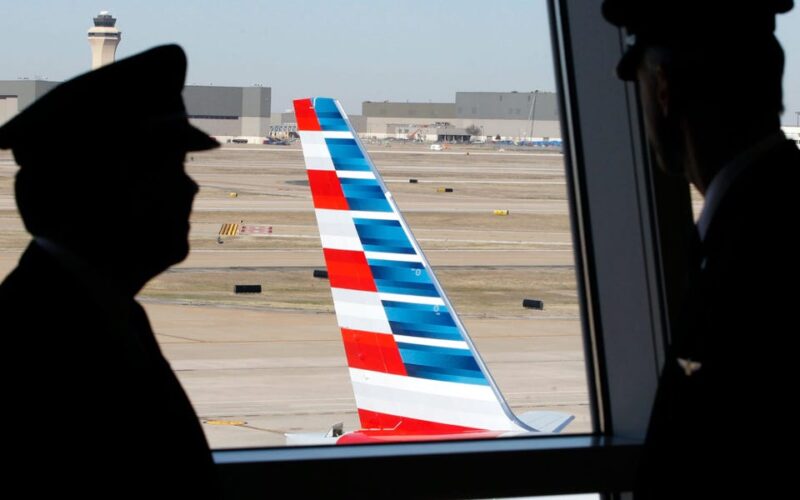Airline pilots, who are responsible for hundreds of lives daily, dedicate years of training and studying to earn their seats in the cockpit.
Most start their careers flying smaller jets at regional airlines and build up to flying Airbus and Boeing planes at the mainline carriers. Before they can fly passengers, however, new hires must complete weeks of ground and simulator training.
I recently toured the flight academy at American’s headquarters in Dallas/Fort Worth, Texas, with Alan Johnson, American’s managing director of flight training and standards and veteran captain.
Taylor Rains/Business Insider
“It’s not a cakewalk; it’s challenging,” he said. “We put our pilots into stressful situations, and that’s good because when they leave here, we want them to not only have the competence but the confidence to go out into the operation and do what the airline asked them to do.”
New hires must complete about three weeks of ground and simulator training
Johnson said about 2,100 new pilots were hired by American in 2023, who joined the company’s roster of some 15,000 others.
Most new hires will train to fly American’s Boeing 737 or Airbus A320 family narrowbody airplanes. To earn their type rating, they must spend 19 days completing ground and simulator training, Johnson said.
The first half of the new hire course includes eight days of ground school, followed by an evaluation day.
The flight academy, which is open 365/24/7, has several classrooms and “visual flight trainers” that new hires use during the ground course to prepare for the FAA-approved tests.
“You need to show you can do things like set up different types of approaches and complete an originating pre-flight,” Johnson said.
Taylor Rains/Business Insider
Once new hires complete the first phase of training, Johnson said they will spend five days in American’s giant, multimillion-dollar full-motion simulators.
The 39-strong fleet of simulators is as close as possible trainees can get to flying a real jet from the ground.
These machines can simulate nearly every possible movement in a passenger jetliner, such as turbulence, wind shear, and landing. The latter involves a pitch-down motion to make it feel like the trainees are stopping.
Taylor Rains/Business Insider
“We want trainees to feel really confident with their skillset to fly around weather, be able to make the decision to divert, and know what to do when they have a medical emergency,” he said, among other responsibilities.
I experienced a 787 flight simulator, and it was as real as it gets
American let me experience a Boeing 787 Dreamliner simulator and its full movement. It was as realistic as I imagined, simulating everything from takeoff and cruise to emergency alarms and landing.
Taylor Rains/Business Insider
A 787 instructor flew a simulated trip from Seattle-Tacoma International Airport to Mount Rainer and back, showing me how pilots use systems like the heads-up display, the flaps, and the autopilot.
Johnson said the training sessions last four hours and are split into two two-hour blocks with a short break in between. Two new hires will train together and switch between the roles of pilot monitoring and pilot flying.
Simulator training covers every phase of flight, with some sessions focusing on specific scenarios, such as go-arounds, slow flight situations, and steep turns.
Taylor Rains/Business Insider
Instructors will also throw emergency situations at the new hires, like engine and generator failures, flaps that don’t extend properly, and pitot tubes that get blocked and give an unreliable airspeed.
“You’ve got sirens and clackers that you cannot silence, all those distractions,” Johnson said, who has about 20,000 hours of flight time under his belt piloting everything from the MD-80 to the 787. “We train for all of it.”
After those five days, the new hires will complete a few more evaluations before operating a simulated gate-to-gate roundtrip flight. This is all in preparation for the final type-rating test, which is conducted by the FAA at the academy in partnership with American.
American’s most senior widebody captains make $447 per hour
Once pilots pass all of their necessary checks and have their type rating on the jet they trained to fly, they start their “operating experience,” or OE.
Johnson said OE involves flying 25 hours of revenue passenger flights with a check airman, who is a specific instructor authorized to conduct line evaluations.
CHARLY TRIBALLEAU/AFP via Getty Images
“All of the new hires we trained at American in 2023, 96% of them went through training without any additional time,” he said. “That’s a testament to our instructors.”
Still, the schooling never stops. Veteran pilots complete recurrent training every year to maintain their proficiency and skills. Their seniority at American — and at Delta and United, for that matter — comes with a pretty paycheck.
At the US’ three largest airlines, new-hire pilots start with a base pay of $116 per hour, or $111,000 yearly. 12-year widebody captains can make up to $447 per hour, or about $430,000 a year.
That’s before per diem, bonuses, and other extra pay.
Source link
lol

